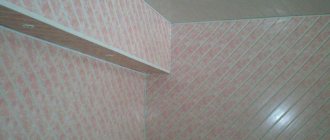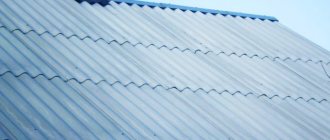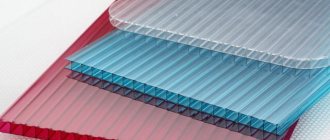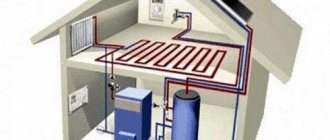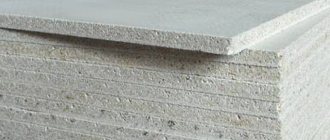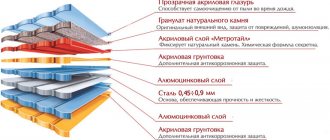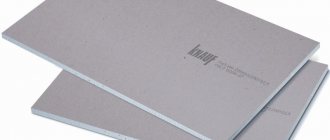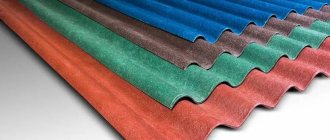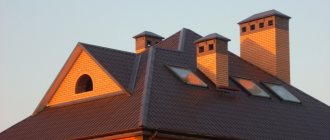Slate is the most common roofing material, a leader in its field of application for several decades.
The name “slate” is not entirely correct; real slate is a natural layered mineral.
The exact designation of the roofing material sounds like asbestos-cement sheet, but the name “slate” has stuck for a long time and there is no point in changing it.
There are two main types of material available : flat and wave. Flat is used for facing work or for the construction of partitions for auxiliary and utility rooms.
Only wave roofing is used as a roof covering ; it is stronger and stronger than flat roofing due to the stiffening ribs created by the waves.
The long-term widespread use of slate is a consequence of high reliability, durability and ease of installation. The relatively recent appearance on the market of many alternative roofing coverings made of synthetic materials, metal or bitumen, has not been able to radically change the situation, since the traditional, time-tested approach to materials prevails among builders.
Technical characteristics of wave slate
Wave slate is a roofing material in the form of wavy sheets of rectangular shape. To produce slate, a plastic molding composition is used, the components of which are:
- Portland cement. The grades used are M300-500, the percentage of material present is 80-90%.
- Chrysotile asbestos. (10-20%).
- Water.
IMPORTANT!
The roles of the components are distributed as follows: Portland cement acts as a connecting link, and chrysotile asbestos is a reinforcing element . After the mass hardens, a strong and hard sheet material is obtained.
Traditionally, the material is produced in a light gray natural color , but recently coating samples made with additives of dyes to give a certain color have appeared on the market, which has significantly improved the aesthetic perception of the material.
Installation is carried out by attaching overlapping sheets using slate nails to the rafter system. Ridges and connecting elements that make up the roof covering are also produced by industry, but often builders do not know about this and use metal elements, which worsens the appearance of the roof.
Slate production and its composition
The main component of slate is a natural mineral – asbestos. When added to cement mortar, asbestos fibers are combined. The result is a very hard material – asbestos cement. Its properties do not change when exposed to moisture, high and low temperatures, and various physical activities.
Chrysotile asbestos is usually used. The mineral is fluffed up, Portland cement and water and various additives are added to it. The working composition is pulp; when preparing it, you must strictly follow the recipe in order to obtain good quality.
There are various slate production plants. At the first stage, the pulp is kneaded. For this purpose, bucket mixers are used. After thorough mixing, the mixture is removed, the liquid is allowed to drain and sent to a sheet molding machine.
This is where the material is pressed. The duration of the process depends on the type of equipment and pressure. Typically, slate is pressed from 30 to 90 seconds. The continuous strip moves along a special conveyor; a special drum forms strips of a certain thickness.
Rotary shears cut the strips into sheets of the required length. Next, the drums begin to work, forming a wave of slate. Their shape and size determine the geometric characteristics of the finished sheets. The finished sheets move along a conveyor and go through the primary curing stage.
The next stage is water saturation of the workpieces. They are kept in a special pool for a certain time and then sent for drying. This occurs in a warehouse with constant high temperature. This is where the material gains its final strength.
Currently, the production of colored slate is common. This increases the wear resistance of the material, gives it new qualities and a beautiful appearance to slate roofs. For this, phosphate and acrylic dyes are used.
Wave slate sheet sizes (7 and 8 waves)
According to GOST, there are only two standard sizes:
- 40/150 — wave height 40 mm, wave length — 150 mm.
- 54/200 — wave height 54 mm, wave length — 200 mm.
The dimensions of 8-wave slate also vary depending on the type. By profile type, sheets are divided:
Unified
Marked with the abbreviation UV.
Dimensions according to GOST
Slate 8 wave sheet size:
- Sheet width - 1130 mm;
- Length - 1750 mm;
- Sheet thickness is 5.8 mm for profile 40/150 and 6-7.5 mm for profile 54/200.
Slate size 7 wave:
- Sheet width - 980 mm;
- Length - 1750 mm;
- Sheet thickness is 5.8 mm for profile 40/150 and 6-7.5 mm for profile 54/200.
Slate size 6 wave:
- Sheet width - 1125 mm;
- Length - 1750 mm;
- Sheet thickness is 5.8 mm for profile 40/150 and 6-7.5 mm for profile 54/200.
Wave slate size
Ordinary
Denoted as VO.
- Sheets 680 mm wide;
- length - 1120 mm;
- sheet thickness 5.8 mm for profile 40/150 and 6-7.5 for profile 54/200.
The size of 8 wave slate can vary within small limits.
Reinforced
The profile marked VU is intended for industrial purposes, has an increased thickness - 8 mm , sheet width 1000 mm, length - up to 2800 mm.
The maximum permissible dimensional deviations are ±15 mm in length and +10 and -5 mm in width.
Flat slate
Now let's look at the dimensions of flat slate. Let's start with the fact that the flat version of this roofing material is presented in two types on the market: pressed and non-pressed. The first differs from the second in increased strength, so slabs with larger sizes are produced from it.
But GOST does not indicate this. This document simply indicates the dimensional parameters. Here they are:
- slab length sizes: 1500, 1750, 2000, 2500, 3000, 3600 mm;
- width sizes: 1000, 1130, 1200 and 1500 mm;
- thickness varies in the range of 6-30 mm, but the most popular panels are 6.8 and 10 mm thick.
We must pay tribute to the manufacturers who today are ready to produce flat slates of any size, meaning non-standard ones.
Attention! If construction requires large slabs, then it is better to give preference to the pressed type.
Number of waves
The number of waves is already determined by the name - 7-wave and 8-wave.
In individual construction, a 7-wave sheet is most often used, since it is lighter and easier to lift to the installation site manually.
At the same time, its useful area is smaller than that of an 8-wave one , since the amount of overlap for both brands is the same and the difference of one wave is not compensated for by anything.
However, a study of demand shows the predominant use of the 7-wave option.
Use in construction
Its main use is roofing. Roofs in individual and low-rise housing construction. Longitudinal ridges serve as stiffening ribs and increase the load-bearing capacity of such a coating. This is facilitated by a thick sheet of at least 5 mm.
8-wave slate has convenient sheet sizes, which makes it easier to install. It should not be used for complex roof structures, as this will generate a lot of waste and the economic feasibility of use will be low. It is also not suitable for roofs with a slope of less than 120. Water will not drain well from such a coating, and its humidity will increase.
Slate is often used for fencing. Low fences made of wavy slate on personal plots are especially good. Painted in different colors, they add a special touch to the architecture of the garden. Another possibility of using slate is in the enclosing structures of outbuildings.
How much does a slate roof weigh?
The weight of the sheet is an important indicator on which the load on the rafter system depends. So, let's find out how much a sheet of 8-wave and 7-wave slate weighs.
The weight of the 40/150 profile sheet is:
- 23.2 kg - weight of 7 wave slate;
- 26.1 kg - weight of 8 wave slate.
For profile 54/200, the weight is 26 and 35 kg, respectively.
The weight of 8 wave slate 1 m2 is approximately 10.41 kilograms.
It is noted that the weight of slate is greater than that of its competitors among roofing materials, which creates certain requirements for the design of the rafter system. Wind and snow loads should also be taken into account ; with a large roof area, the weight of water absorbed by the coating during rain can play a role.
Weight of corrugated slate
Calculation of the mass of roofing material
Knowing the weight of 1 sheet of corrugated slate when working with it is necessary for many craftsmen for a number of reasons:
- The exact mass of the roofing covering and the entire pie allows you to most accurately calculate the load on the roof rafters, and therefore make them as strong as possible;
- Also, the weight of the slate sheet allows you to calculate the total load from the finished roof, which will ultimately fall on the walls and foundation of the building;
- Knowing the final weight of the roofing material makes it possible to profitably manage funds for transporting the material from the store to the home;
- In addition, knowing the weight of one layer of covering, the master can calculate the labor costs for constructing the roof and pay for them accordingly.
Important: sometimes it happens that the total mass of the finished asbestos-cement roof requires significant reinforcement of the rafters and foundation/walls. In this case, it may happen that a more expensive, but lightweight roofing material will still be more cost-effective than slate. This option should not be discounted when making construction calculations.
Effective area
The sheets are installed with an overlap, 1 or less often 2 waves are overlapped. In this case, the useful area of the sheet is reduced by the amount of overlap.
- For a 7-wave sheet, the usable area is 1.336 square meters. m .;
- wave slate is 1.57 sq.m.
The dimensions are indicated with an overlap of 1 wave, which is most often used in construction. Sometimes in some places it may be tempting to lay the sheet end-to-end to save material.
CAREFULLY!
It is impossible to lay sheets end-to-end, as leaks will occur at all joints.
Saving one or two sheets will result in water entering the room.
Overlap width
Why “weigh” the roof
From a mechanical point of view, the mass of a structure is determined by the weight of its parts.
However, in most cases it is also an indication of strength.
Slate with a thicker sheet actually has higher strength characteristics and seems to be a more profitable solution.
- The large weight of the roofing material will require strengthening the rafter structure: choosing thicker timber, constructing additional elements, installing more frequent sheathing from more massive slats.
As a result, the total weight of the roof increases significantly, which, in turn, will create an additional load on the walls of the structure and the foundation. - The weight of the roof depends not only on the weight of the slate sheet itself, but also on the installation method.
Slate is laid with vertical and horizontal overlap. This value varies depending on the angle of inclination and wind load. - Another aspect is efficiency.
Slate is one of the most affordable roofing materials. However, with the overall strengthening of the structure, the cost of the roof may turn out to be so high that the use of more expensive and reliable, but lightweight roofing materials will be more profitable.
Advantages and disadvantages of slate covering
Wave slate has a number of undeniable advantages:
- Long service life. On average, the coating retains its quality for about 40 years or more, depending on the conditions of use. It is noted that even under the most unfavorable factors, the coating lasts at least 10 years.
- Easy to install . The work does not require high qualifications; it is enough to have a general understanding of installation techniques.
- Allows partial repair or replacement of individual sheets that have become unusable.
- The strength of the material contributes to safety during installation - the slate covering can easily support the weight of a person and allows walking on the covering.
- Does not accumulate electric charge , absolutely safe in terms of fire.
- Much cheaper than other roofing materials.
- The relatively light weight of the coating allows you to do without construction lifting equipment during installation.
Advantages of coverage
It is impossible not to mention the negative qualities of slate. These include:
- Fragility of the material . Slate is not plastic and does not allow any deformation.
- The ability to absorb moisture shortens the service life and causes the formation of fungus, mold, and over time moss appears, which must be cleaned off. This deficiency can be neutralized by coloring.
- The content of asbestos as a component of the material is a significant health hazard.
NOTE!
Asbestos is a strong carcinogen , which has caused a reduction in its use in industry.
This is the main reason for the displacement of slate from the market, although there are no definite medical statistics on this matter. There is data for enterprises showing the percentage of morbidity among workers, but there is no statistical information for residents of slate-covered houses.
Nevertheless, the danger exists and must be taken into account. Installation work should be carried out using personal respiratory protection.
Material deficiencies can be neutralized without any particular difficulties, you just need to be aware of them and take appropriate measures to prevent possible incidents. At the same time, the obvious advantages, tested and confirmed by many years of practice, convincingly speak in favor of slate as an advantageous and reliable roofing covering.
It is profitable to purchase construction products
The group offers to carry out wholesale purchases of building materials of the required quality level. We sell products from reliable suppliers, making sure that the rights and needs of customers are respected.
When laying your first sheets of slate purchased from AlfaCem, you will understand that the mechanical characteristics correspond to the declared ones, the dimensional characteristics are accurate down to mm, and the weight does not have to be calculated, because The mass of the slate surface is specified in the accompanying documentation.
All clients are guaranteed a competitive pricing policy - you can always purchase building materials in reserve for the complete installation of roofs at any height. A detailed site map will allow you to get acquainted with all the information about the nuances of cooperation with AlfaCem. Also read user comments and be sure to leave your own reviews about your purchasing experience in our company. We wish you success!
Practical advice for dismantling slate
Dismantling old slate requires attention and skill, and compliance with safety regulations is mandatory. In addition to the fact that work has to be done at height, all structures have already lost their original strength indicators, which greatly increases the likelihood of emergency situations.
Important. You must always use a special ladder on the roof. It doesn’t take long to do it, but the work becomes safe, the process of dismantling the old roof is significantly accelerated.
Safety measures when dismantling slate
To remove slate, you will need three ordinary nails with a length of at least 100 mm, a piece of rope ≈ 2 m, an extension ladder (its dimensions should allow the upper part to rest against the slope), and the main rope for lowering the slate sheets to the ground.
Step 1: Prepare your nails. They must be bent in the Latin letter Z, but one end at an angle of 180°, and the other at an angle of ≈140°. This form of nails will ensure reliable and quick fixation of the rope, which speeds up the dismantling process and makes it safe. In addition, old sheets are preserved and can be used to install roofs over other outbuildings that do not require the use of new roofing materials.
Nails are bent into hooks
Step 2. Nail or screw wooden boards or slats to the ladder. The distance between them should be equal to the pitch of the waves. In most sheets, the wave pitch is 200 mm, which means that the distance between the runners must be 60 cm.
Additional runners are screwed to the stairs
Important. The elements should protrude beyond the legs of the stairs to approximately the height of the slate wave. In our case, this parameter is equal to four centimeters.
Due to the runners, slate sheets completely prevent falling on one side; all materials retain their original characteristics. In addition, it is much safer to work below, minimizing the likelihood of slate falling on your head.
Step 3. Make another staircase using the same dimensions; it will be installed on the slope. The second ladder is temporarily fixed to the sheathing and moves as the slate roof of the house is dismantled. If there is a concern that the connection of two stairs is unreliable, then you need to come up with any temporary locks or latches. They will ensure a stable position of the elements regardless of the actual lateral loads.
Another ladder is attached to the roof slope
Step 4. Make a so-called “spider” from two bent nails and a piece of rope. This is a special device for supporting slate sheets by the lower edge while lowering them to the ground. Hooks are made this way.
- Tie a piece of rope about two meters long to the main long one. You should tie it in the middle; the two hanging sections should have the same dimensions. Otherwise, the sheet will warp, and this position may cause the wave to break off the runners.
- Tie bent nails to the ropes. The ends of the nails that are bent at an angle of 180° should be fixed. To prevent them from falling out, it is recommended that after fixing, bend the end of the nails as much as possible and in this way securely clamp the rope.
Now the second (bottom) hooks of the nails are placed on the edge of the slate and firmly hold the sheet in a vertical position.
Rope and nail hooks securely hold the sheet in an upright position
Step 5: Remove the slate nails securing the sheet, lay it on the stairs and secure the ropes. One person should stand behind the skate and hold the rope with their hands, then gradually release it. The sheet slowly moves downwards along the runners.
The sheet is fixed with a rope and carefully lowered down
Step 6: Downstairs, another helper takes the slate sheets and stacks them. At the same time, sorting is carried out: whole ones are put in one place, cut ones in another, and cracked and completely unusable ones are thrown onto a pile with construction waste. This technology allows you to completely dismantle slate sheets from a house in just one work shift.
The sheets removed from the roof are placed in a pile on the ground.
Practical advice. If the sheet has a large crack, it is recommended not to lower it to the ground, but to immediately break it on the roof and throw it away.
The fact is that there is a high probability of it cracking during descent, this is very dangerous. Pieces of slate can injure the worker below, and the helper above can fall from the roof due to unexpected loss of load.
Dismantling the roof without saving sheets
Why do you need to dismantle old slate?
Before making the final decision to dismantle your old slate roof, you should weigh the pros and cons. The fact is that replacing a roof is a rather expensive construction project. During its implementation, unforeseen problems may arise, which further increase the estimated cost of repairs. When should old slate be removed?
- Critical physical wear and tear. Externally, the slate sheets do not have significant damage and look quite normal, but due to natural aging, the strength of the slate decreases significantly, it becomes very fragile, in some cases the sheets are easily broken off by hand. This coating can suffer significant damage at any time during heavy rain. As a result, water gets not only into the attic, but also into the living rooms. You will have to repair the finishing of the ceilings and walls of the interior, and this greatly increases the cost of repairs. Conclusion - you should not expect big problems to appear; it is much more profitable to replace the old slate in a timely manner.
Over time, slate loses its density and is easily damaged even with minor impact
If there are cracks in the slate, the roof needs to be replaced
A roof overgrown with moss gives the entire structure an unattractive, sloppy appearance.
Depending on the condition of the slate and the qualifications of the craftsmen, the old coating can be reused or it has to be taken to a landfill for disposal of construction waste. For transportation, you should know approximately the total weight; this value is determined taking into account the mass of a square meter of slate during disassembly.
Prices for different types of slate
Slate weight 1m2 when disassembled
If not so long ago slate was considered the traditional and most popular roofing material, today it is a rather rare roofing option for new buildings. Asbestos-cement slate is found infrequently and is mainly found in utility rooms, garages and other outbuildings. At new facilities it was replaced by modern, more reliable, beautiful and durable roofing materials. But old buildings are still in most cases covered with asbestos-cement slate. Such buildings have been in use for many years, and therefore there is a need to completely replace the roof.
Slate weight 1m2 when disassembled
Scope of application of the material
Flat slate is widely used in a variety of fields. That is, its use is not limited only to the construction area, although this is where it is used most actively. The material is successfully used in the construction of:
- shopping pavilions;
- office buildings;
- private residential buildings;
- gazebos;
- fences and fencing;
- garages.
The products can also be used:
- when installing foundations;
- when facing facades;
- for interior decoration;
- for the installation of partitions;
- for installation of subfloor;
- for the construction of beds;
- when finishing cellars.
And this is not a complete list of applications for slate sheets. However, it should be borne in mind that for a longer service life of the material, it is necessary to carry out an annual inspection of its surface and, if necessary, update the protective layer, which may consist of a special paint for slate or varnish.
In conclusion, it can be noted that when purchasing flat slate, you should pay attention to the product labeling. It is mandatory to indicate the name of the company producing the material, the batch number and the date of manufacture, as well as the necessary technical parameters that comply with GOST, that is, the thickness of the sheet, its type and the exact dimensions of the flat slate. In addition, it is worth checking the availability of certificates for the goods being sold.
Video on the topic
The most common acls ↑
Flat slate 10 mm ↑
LP 10 mm is used in cladding the front sides of various structures, when arranging solid fences or as a base for a floor or roof. They can also be used to construct internal partitions. Due to its absolutely flat surface, the material combines well with various finishing materials.
8 mm option ↑
8 mm material has proven itself to be excellent and has been widely in demand in industrial construction for decades. Among its basic characteristics are fire resistance, strength, and long service life. It should be noted that the material is resistant to atmospheric influences. An important factor is also the optimal combination of price and quality.
6 mm ↑
ACL of this thickness is often used as exterior finishing, internal non-load-bearing partitions, for flooring, etc. But even with this thickness they are difficult to cut. Using a ruler and, for example, a sharp chisel, notches are made on both sides at the site of the future cut. Then the ACL is placed on a flat base with a sharp edge, aligning it with the cut, and carefully broken. To cut thicker sheets, it is recommended to use an electric circular saw, which is periodically cooled with water during operation.
Before starting facing work, it is recommended to paint asbestos-cement sheets with nitro paint using a spray gun.
It is better if, when painting, they are located horizontally, then the paint will fill all the surface irregularities. Such a result would not have been possible to obtain in a vertical position.
